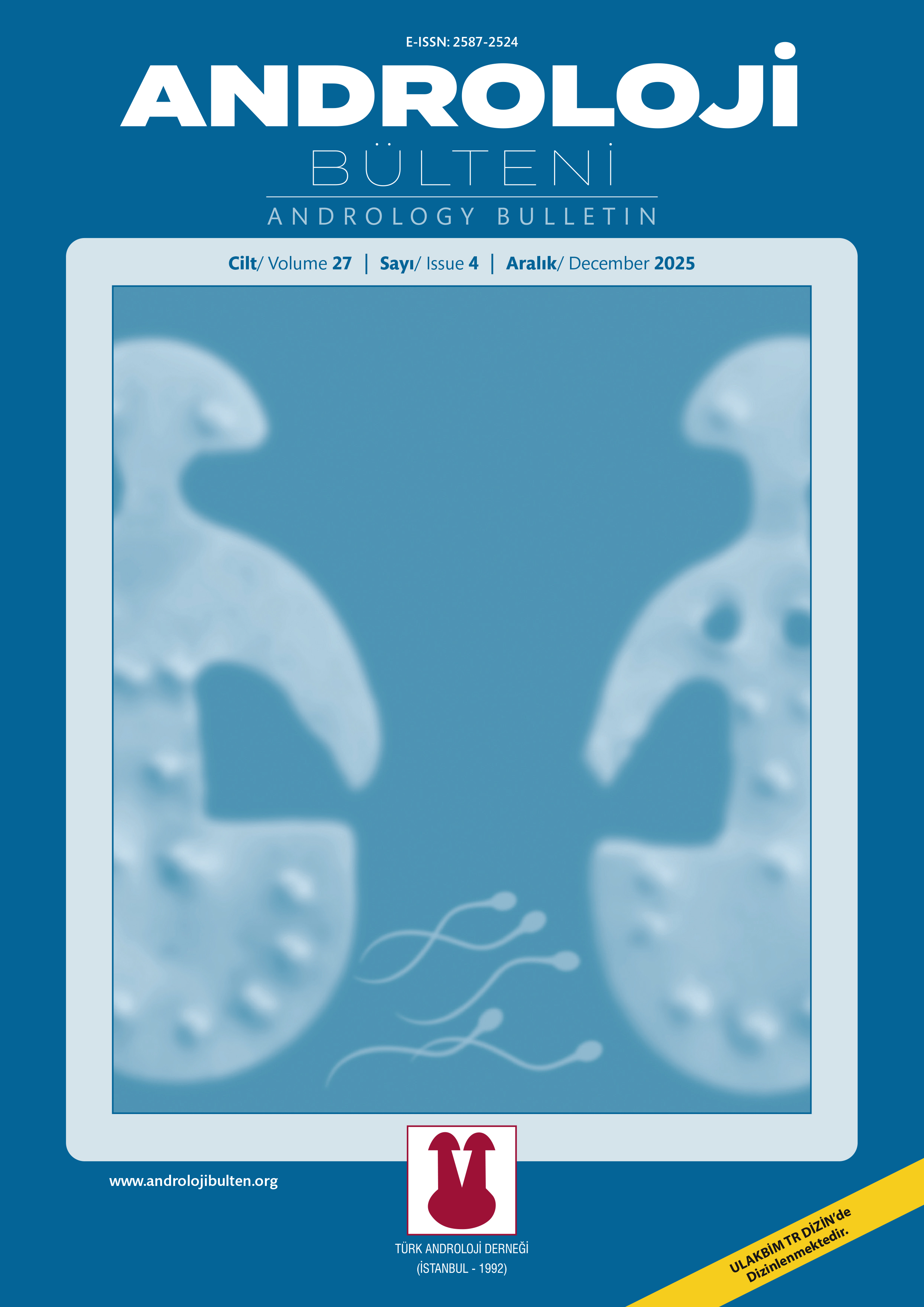
Content of this journal is licensed under a Creative Commons Attribution-NonCommercial 4.0 International License.
The comparison of the effect of Isoeugenol-based novel potent antioxidant and melatonin on testicular tissues in torsion induced rat model
Fikret Erdemir1, Esra Fındık2, Mustafa Ceylan2, Erkan Söğüt3, Sevil Çaylı4, Hakan Kesici41Gaziosmanpasa University, Faculty of Medicine, Department of Urology, Tokat2Gaziosmanpasa University, Faculty of Arts and Sciences, Department of Chemistry, Tokat
3Gaziosmanpasa University, Faculty of Medicine, Department of Biochemistry, Tokat
4Gaziosmanpasa University, Faculty of Medicine, Department of Histology and Embriology, Tokat
INTRODUCTION: Testicular torsion is an ischemic process. Although detorsion of testis is necessary for treatment, it has been shown that this approach may lead to oxidative damage via release of reactive oxygen species. Various antioxidant agents have been used previously to show their antioxidative effects on ischemia-reperfusion injury in many organ systems. In present study the effect of new antioxidant agent on testicular tissues was evaluated in testicular torsion induced rat model.
METHODS: Thirty-two male Wistar albino rats, age 5.5 to 6 months and weighing 250 to 300 g, were used in this study. The rats were randomly divided into four groups. Group 1 (n=8) control group; the rats in this group were used to determine basal values for biochemical and tissue evaluation. In Group 2 (n=8), torsion and detorsion was created. Group 3 (n=8) received a 50 mg intraperitoneally melatonin to determine the effect of melatonin on serum and tissue oxidative stress parameters after testicular torsion/detorsion is created. Group 4 (n=8) received a 30 mg intraperitoneally new antioxidant agent to determine the effect of this agent on serum and tissue oxidative stress parameters after testicular torsion/detorsion is created. The tissue levels of oxidative stress parameters such as malondialdehyde (MDA), superoxide dismutase (SOD), glutation peroxidase (GSH) were studied in all groups. The serum levels of the same parameters were also studied in the blood (5 ml) which were drawn from the vena cava inferior of all the rats just before sacrification.
RESULTS: The serum levels of MDA, SOD and GSH increased in the Group 2 in comparison to the control (P<0.05). Administration of melatonin caused a decrease in lipid peroxidation and antioxidant enzyme activities when compared to the torsion group (P<0.05). Administration of new antioxidant also decreased the levels of MDA, SOD and GSH in serum in comparison to Group 2. After treatment with melatonin and new antioxidant the testicular damage was diminished. Testicular germ cell apoptotic index was detected as 1.5%, 15%, 3.2% and 6% in Groups 1, 2, 3 and 4 respectively (p<0.05). There was no statistically significant difference between Group 3 and Group 4 in terms of serum antioxidant activity.
DISCUSSION AND CONCLUSION: The results of this study showed that experimentally induced testicular torsion causes oxidative stress. The new antioxidant agent decreased the negative effect of oxidative stress in testicular torsion. This new antioxidant agent can be used alternatively to decrease the negative effects of testicular torsion.
Keywords: Testis, torsion, treatment, antioxidant, melatonin
İzogenol tabanlı etkili yeni bir antioksidanın testis torsiyonu oluşturulan ratlarda testis dokuları üzerine olan etkilerinin melatoninle karşılaştırılması
Fikret Erdemir1, Esra Fındık2, Mustafa Ceylan2, Erkan Söğüt3, Sevil Çaylı4, Hakan Kesici41Gaziosmanpaşa Üniversitesi Tıp Fakültesi, Üroloji Anabilim Dalı, Tokat2Gaziosmanpaşa Üniversitesi Fen Edebiyat Fakültesi, Kimya Bölümü, Tokat
3Gaziosmanpaşa Üniversitesi Tıp Fakültesi, Biyokimya Anabilim Dalı, Tokat
4Gaziosmanpaşa Üniversitesi Tıp Fakültesi, Histoloji ve Embriyoloji Anabilim Dalı, Tokat
GİRİŞ ve AMAÇ: Testis torsiyonu iskemik bir süreçtir. Her ne kadar tedavide detorsiyon gerekli olsa da bu yaklaşımın reaktif oksijen radikallerinin salınımına bağlı olarak oksidatif hasara yol açtığı gösterilmiştir. Daha önceki çalışmalarda pek çok organda çeşitli antioksidanlar iskemi reperfüzyon hasarlarında antioksidan etkilerini göstermek üzere kullanılmıştır. Sunulan bu çalışmada testis torsiyonu oluşturulan rat modelinde yeni bir antioksidanın etkileri araştırılmıştır.
YÖNTEM ve GEREÇLER: Bu çalışmada, ağırlıkları 250–300 gr, yaşları 5,5–6 ay olan toplam 32 Wistar cinsi erkek albino rat kullanıldı. Ratlar randomize olarak dört gruba ayrıldı. Grup 1 (n=8) kontrol grubu olarak alındı ve bu gruptaki ratlar doku ve biyokimyasal bazal değerlerin değerlendirilmesi için kullanıldı. Grup 2’de (n=8), torsiyon ve detorsiyon oluşturuldu. Grup 3’te (n=8) testis torsiyon/detorsiyon oluşturulduktan sonra melatoninin serum ve doku oksidatif stres parametreleri üzerine olan etkilerini değerlendirmek için 50 mg intraperitoneal melatonin verildi. Grup 4 (n=8) testis torsiyon/detorsiyon oluşturulduktan sonra yeni antioksidan ajanın serum ve doku oksidatif stres parametreleri üzerine olan etkilerini değerlendirmek için 50 mg intraperitoneal yeni ajan verildi. Malondialdehid (MDA), superoksit dismutaz (SOD) ve glutatyon peroksidaz gibi doku oksidatif stres parametreleri tüm gruplarda çalışıldı. Ratların sakrifiye edilmelerinden hemen önce vena kava inferiordan alınan 5 ml’lik kanda aynı parametrelerin serum seviyeleri çalışıldı.
BULGULAR: Serum MDA, SOD ve GSH seviyeleri kontrol grubu ile karşılaştırıldığında, Grup 2’de anlamlı olarak arttı (P<0,05). Melatonin verilmesi torsiyon grubu ile karşılaştırıldığında lipid peroksidasyonu ve antioksidan enzim aktivitelerini azalttı (P<0,05). Ayrıca, yeni antioksidan ajan verilmesi de Grup 2 ile kıyaslandığında serumda MDA, SOD ve GSH seviyelerini azalttı. Melatonin ve yeni antioksidan tedavisi sonrası testis hasarı azaldı. Testiküler germ hücre indeksi Grup 1, Grup 2, Grup 3 ve Grup 4’te sırasıyla %1,5, %15, %3,2 ve %6 olarak tespit edildi (p<0,05). Antioksidan aktivite açısından Grup 3 ve Grup 4 arasında anlamlı fark saptanmadı.
TARTIŞMA ve SONUÇ: Bu çalışmanın sonuçları ratlarda deneysel testis torsiyonu oluşturulmasının oksidatif strese neden olduğunu gösterdi. Yeni antioksidan ajan testis torsiyonundaki oksidatif stresi azalttı. Bu yeni antioksidan ajan testis torsiyonuna bağlı olumsuz etkileri azaltmak için alternatif olarak kullanılabilir.
Anahtar Kelimeler: Testis, torsiyon, tedavi, antioksidan, melatonin
Manuscript Language: Turkish
(1005 downloaded)













